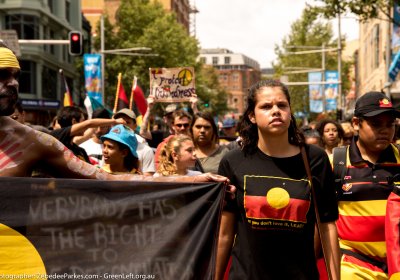If you want to celebrate January 26 by all means do: just be clear that you are celebrating those with so much wealth power that they will never need, nor want to, invite you to feast with them.
change the date
Prime Minister Scott Morrison has made a disingenuous pitch for “unity” and “honesty” in response to Byron Bay Council’s decision on September 20 not to celebrate Australia Day, in deference to the hurt it engenders to Indigenous peoples.
If national unity and harmony are the goals for Australia’s national day, then January 26 is no longer, if it ever was, fit for purpose. It does not meet its objective and, no matter how much it “disappoints” Prime Minister Malcolm Turnbull, we need to re-think Australia Day.
If you’ve had the misfortune to watch former Labor leader Mark Latham’s video on changing the date of Australia Day you’ll know how desperate the debate has become.
Latham presents a world of full surveillance, where citizens live in fear of their secret lamington and lamb celebrations of our wide, brown land being discovered by the unseen politically correct police — followed by a call by Alice Springs town councillor and Warlpiri woman Jacinta Price to not be ashamed to celebrate Australia’s national day.
The Hobart City Council has officially joined the campaign to change the date of Australia Day.
It will also provide support for the annual Invasion Day march, organised by the Indigenous community, and back councillors who take part.
On October 23, the council passed a four-point motion seven votes to two.
It also called on other local governments to lobby the federal government to move Australia Day from January 26.
But it will not stop holding its citizenship ceremonies and celebrations on Australia Day.
The Council of Australian Postgraduate Associations (CAPA) and The National Aboriginal and Torres Strait Islander Postgraduate Association (NATSIPA) support renaming January 26 as “Invasion Day”. The two organisations decided this on January 15.
They are encouraging a rethink of the meaning of "Australia day" on January 26 to support justice for Aboriginal and Torres Strait Islanders. They are also urging people to attend one of the many nationwide protests on January 26 (see below).
When Fremantle councillors voted in August last year to end the Australia Day fireworks display that it had been running for the past eight years, I fully expected a conservative backlash. But even I was surprised to see the decision featured in news bulletins for months on end.
On one level the whole thing is bizarre. Local governments are not obliged to do anything special on January 26 and most of them don't.
What drove the conservative media and Coalition politicians into a frenzy was the council's reason for doing dropping the fireworks display.
As Invasion Day approaches, Murri leader Sam Watson told Green Left Weekly that January 26 was “only a date when a motley collection of boats made landfall on Gadigal country to establish the colony of NSW”.
“It is important to mobilise and march [on Invasion Day] to remind everyone that an illegal invasion took place on this soil," he said..
“They came here to launch a war of genocide against the 500 sovereign nations of this land.
“They came to invade as a fully-armed military force. They massacred and slaughtered tens of thousands of innocent people.








